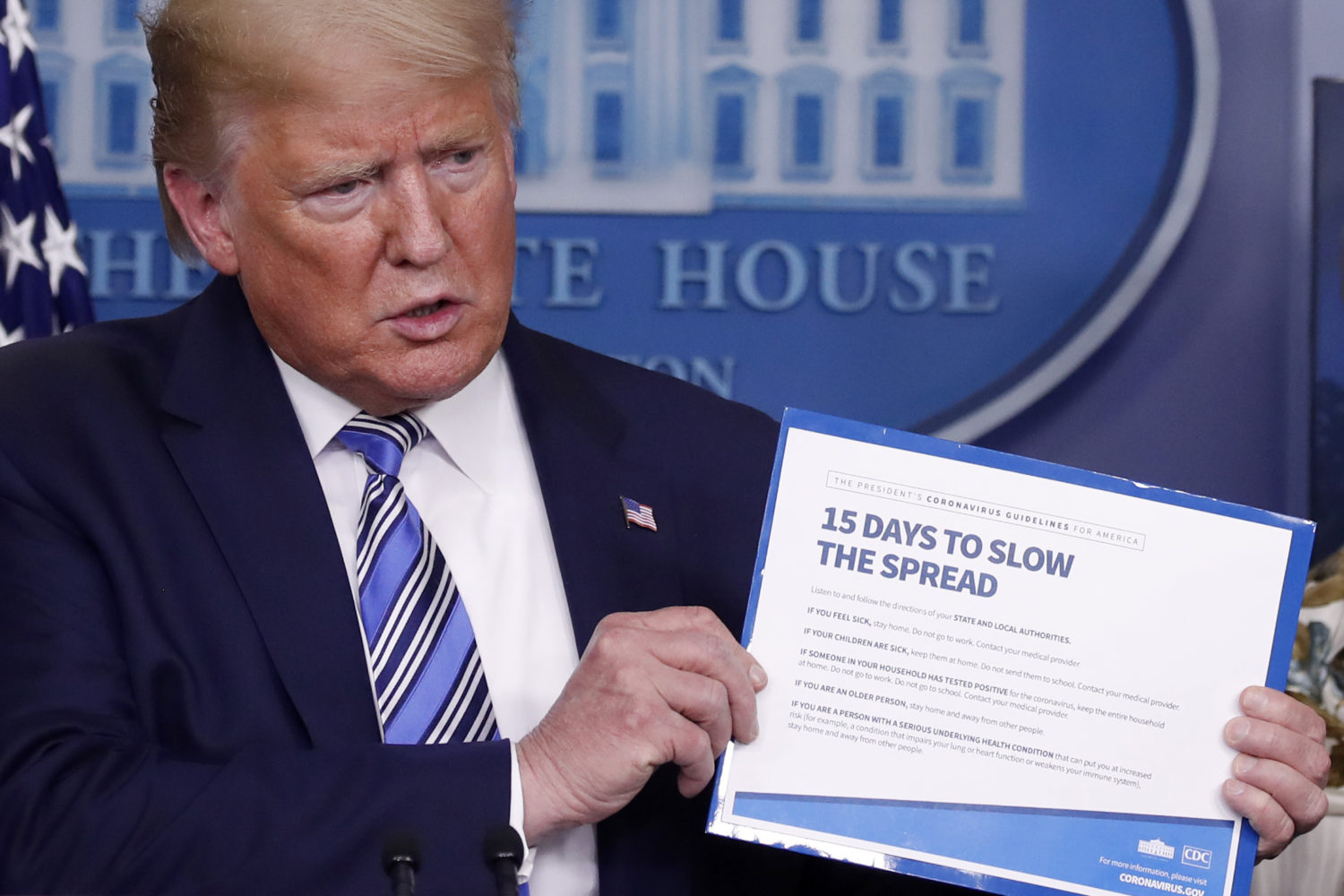Editor’s note: PolitiFact, which is owned by the Poynter Institute, is fact-checking misinformation about the coronavirus. This article is republished with permission, and originally appeared here.
In the span of three months, Americans went from hearing about a new virus in central China to being told they ought to stay home and avoid groups larger than 10. President Donald Trump went from telling people not to worry and everything was under control to leading daily press conferences on containing the outbreak in the United States.
The rapidly evolving story can be broken down into three phases: the emergence of the threat, the government’s focus on keeping it out of the United States, and finally, its efforts to contain the spread.
Here are the key moments in each phase, and what Trump said at those times — fact-checked.
The disease emerges
Dec. 31: China confirms existence of a new virus.
Jan. 20: World Health Organization reports cases in China, Thailand, Japan, and South Korea.
Jan. 21: The first U.S. case is announced in Washington state (as well as Vietnam and Singapore). WHO says the virus risk globally is high.
Jan. 22: A reporter asks if there are worries about a pandemic. Trump responds:
“No. Not at all. And we have it totally under control. It’s one person coming in from China, and we have it under control. It’s — going to be just fine.”
Jan. 24: Trump tweets, “It will all work out well.”
China has been working very hard to contain the Coronavirus. The United States greatly appreciates their efforts and transparency. It will all work out well. In particular, on behalf of the American People, I want to thank President Xi!
— Donald J. Trump (@realDonaldTrump) January 24, 2020
Jan 29: The White House forms a coronavirus response task force, initially led by Health and Human Services Secretary Alex Azar.
Jan. 30: The WHO declares a global health emergency.
Phase Two: Keeping it out of the United States
Jan. 30: Trump blocks travel from China.
The same night, he holds a campaign rally in Iowa.
“We think we have it very well under control. We have very little problem in this country at this moment — five. … we think it’s going to have a very good ending for it.”
Feb. 2: Trump tells Fox News host Sean Hannity, “We pretty much shut it down coming in from China.”
Feb. 4: Diamond Princess cruise ship quarantined in Yokohama, Japan. Over 2,600 guests and over 1,000 crew. Within two days, over 40 people test positive for COVID-19, including eight Americans.
Feb. 11: WHO names the new virus COVID-19.
Feb 14: Trump discusses the “very small” number of U.S. coronavirus cases with Border Patrol Council members:
“We have a very small number of people in the country, right now, with it. It’s like around 12. Many of them are getting better. Some are fully recovered already. So we’re in very good shape.”
Feb. 20: WHO reports nearly 77,000 cases worldwide in 27 countries.
Feb. 24: Stock market plummets as Dow Jones Industrials falls more than 1,000 points.
The same day, Trump asks for $1.25 billion in emergency aid. It grows to $8.3 billion in Congress. He tweets that the virus “is very much under control” and the stock market “starting to look very good to me!”
The Coronavirus is very much under control in the USA. We are in contact with everyone and all relevant countries. CDC & World Health have been working hard and very smart. Stock Market starting to look very good to me!
— Donald J. Trump (@realDonaldTrump) February 24, 2020
Feb. 26: The first case emerges in California with no clear source, suggesting community spread of the virus.
In a news conference that day, Trump says the United States is “really prepared.” He puts Vice President Mike Pence in charge of the White House task force.
Feb. 28: Cases rise across Europe, including Italy, Germany, France, England, Switzerland and Belarus.
[the_ad id=”667872″]
Phase Three: Containing the spread
Feb. 29: FDA eases guidelines to speed the broader use of testing.
March 4: House passes $8.3 billion emergency bill, aimed mainly at the immediate health response to the virus.
In a Fox News interview, Trump deflects criticism to his response by saying the Obama administration (including the vice president, Joe Biden) “didn’t do anything about” swine flu. We rated the claim False.
Trump continues to blame the Obama administration in an exchange with reporters at the White House.
“The Obama administration made a decision on testing that turned out to be very detrimental to what we’re doing.”
Our fact-check shows the process dated back to 2006, before Obama took office. So the claim is False.
March 6: Grand Princess cruise ship with over 2,000 passengers waits to dock off the California coast.
Asked about the docking of the Grand Princess, Trump says the following:
“I would rather (Grand Princess passengers stay aboard) because I like the numbers being where they are. I don’t need to have the numbers double because of one ship.”
Trump went on to say that he thought it was more important for passengers to debark than to keep the numbers down.
In a news conference, Trump downplays the concerns around testing:
“Anybody that wants a test can get a test.”
With tests in short supply, we rated the claim Pants on Fire.
The same day, Trump tweets out blame to the media and the Democrats for trying to “inflame” the situation “far beyond what the facts would warrant.”
The Fake News Media and their partner, the Democrat Party, is doing everything within its semi-considerable power (it used to be greater!) to inflame the CoronaVirus situation, far beyond what the facts would warrant. Surgeon General, “The risk is low to the average American.”
— Donald J. Trump (@realDonaldTrump) March 9, 2020
March 11: On the same day the WHO declares COVID-19 a pandemic, Trump uses a prime-time Oval Office address to announce a ban on travel for non-Americans from most of Europe. He misstates a freeze on cargo and falsely said the health insurance industry has “agreed to waive all co-payments for coronavirus treatments.” In reality, getting tested would be free, but treatment would not be covered.
[the_ad id=”667878″]
March 13: Trump declares a national emergency to access $50 billion for states and territories, and clear the way for fast-track waivers for hospitals and doctors as they respond to the virus.
March 14: The House passes a worker and business relief bill with paid leave guarantees for certain workers, expanded food assistance and unemployment insurance benefits, and employer tax credits. Trump signs it four days later.
March 17: Trump said in a news conference that for the next 14 days, “we’re asking everyone to work at home, if possible, postpone unnecessary travel, and limit social gatherings to no more than 10 people.”
Trump says there was no shift in tone from the White House.
“I’ve always known this is a real, this is a pandemic. I’ve felt it was a pandemic long before it was called a pandemic.”
As this timeline shows, Trump minimized the threat of a pandemic for many weeks. Pants on Fire!
Asked if the World Health Organization had offered detection tests to the United States, Trump said WHO had not, and that the WHO coronavirus test “was a bad test.” False. WHO said three independent labs had validated the test, and the White House coordinator for coronavirus response said she assumed the WHO test is effective.
March 19: The U.S. Senate unveils a $1 trillion-plus economic stimulus package. California orders lockdown for 40 million residents.
March 20: New York Gov. Andrew Cuomo ordered all non-essential businesses to keep their workers home.
PolitiFact, which is fact-checking misinformation about the coronavirus, is part of the Poynter Institute. See more of their fact-checks at politifact.com/coronavirus.








